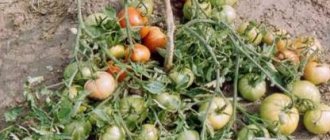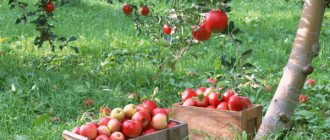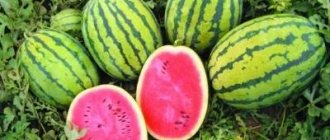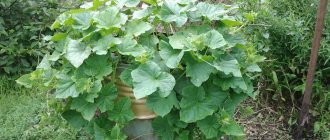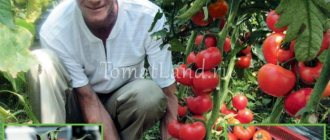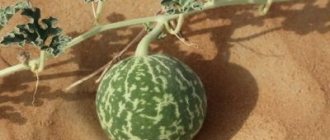Among the extraordinary varieties, the Gigolo tomato occupies a special place. The exoticism of tomatoes is in their amazing shape, elongated and reminiscent of bell peppers. In addition, the fruits have an amazing taste and are widely used in salads and preparations.
| Height | Landing location | Ripening time | Fruit color | Fruit size | Origin | Fruit shape |
| short | Greenhouse, Open ground | Mid-season | Reds | Average | Variety | Pepper-shaped |
Description of the tomato variety Zhigalo
Zhigalo tomato bushes grow small - up to 50 cm, the plant is standard, compact, and does not require a large area. The leaves are dark green in color and medium in size.
Gardeners value the crop for its cylindrical, elongated shape of the fruit. Tomatoes grow up to 4 cm in diameter and an average length of 15 cm.
!!! The weight of Zhigalo tomatoes reaches 140 g.
Tomatoes have a thick, dense skin that does not crack even when overgrown. The skin color is red. The fruits are fleshy and contain very few seeds.
Zhigalo is excellent for preservation due to its characteristics. The unusual shape of the fruit gives canned products their originality.
!!! Tomato Zhigalo is perfect for stuffing. Due to the dense pulp, the fruits do not fall apart and retain their shape.
In cross section, the fruits are very similar to sweet peppers. Zhigalo are dense, fleshy with a small amount of juice, which allows this variety to be dried. The Zhigalo tomato, described by gardeners, is a little dry for fresh consumption, but is excellent for processing.
The taste of the vegetable is sweetish, with a slight sourness. Very good in pickling.
Diseases and pests
The tomato variety Zhigalo cannot boast of special immunity to diseases. However, timely prevention helps prevent infection.
Late blight is a fungal disease that affects not only the plant, but also the fruits. It is known that favorable conditions for the spread of the disease are low temperatures and high humidity. Therefore, if weather conditions worsen, it is recommended to spray tomatoes with Bordeaux mixture and fungicides (Ridomil Gold, Quadris).
As regular preventative measures, it is recommended to mulch the soil and timely remove old and yellowed leaves.
Growing the standard variety Zhigalo is suitable for beginning gardeners and summer residents who are not keen on growing exquisite and rare tomatoes.
Characteristics
The characteristics and description of the variety differ from other varieties. The main characteristics of the Zhigalo tomato include:
- the fruits have an original shape;
- tomato weight 100-140 g;
- a small amount of seeds;
- high productivity;
- good taste;
- thick skin;
- the bush does not branch;
- the ability to plant bushes tightly due to a weak root system.
The Zhigalo tomato, which gardeners leave reviews of, is well stored and transported, unlike most other varieties. The shelf life outside the bush reaches 1.5 months.
Important!!! When the fruits are picked from the bush at technical ripeness, Zhigalo ripen well in the box, but the taste is slightly lost .
The fruit crop has average resistance to diseases, so it is necessary to carefully monitor the plant and carry out preventive treatments with special means.
Comparison table: all the pros and cons of tomatoes
In order to avoid mistakes when growing vegetables, you need to familiarize yourself with the advantages and disadvantages of this variety of tomatoes.
| Advantages | Flaws |
| Unpretentiousness to growing conditions and care | Susceptibility to lesions characteristic of nightshade crops |
| Excellent fruiting and taste characteristics | Due to the small number of seeds in vegetables, difficulties arise when collecting planting material |
| Long shelf life of ripe crops | The fruits contain a high content of dry substances, which does not allow the use of tomatoes of this variety for the preparation of juices, tomato paste and ketchup. |
| Ability to transport over long distances |
Disadvantages also include the low weight of ripened vegetables, which does not manifest itself negatively only in industrial quantities. But for winter preparations, small vegetables are more suitable.
Advantages and disadvantages
The Gigolo variety has many positive qualities, for which it is appreciated by both experienced gardeners and beginners. The undoubted advantages of tomatoes are:
- unusual tomato shape;
- excellent qualities for pickling;
- high productivity;
- small compact bushes;
- excellent commercial qualities;
- good taste;
- unpretentiousness;
- the ability to save seeds for planting.
This fruit crop also has some disadvantages, for example:
- low juice content;
- average disease resistance.
As for diseases, this is typical for many varieties of this culture. Timely preventive measures will minimize the risk of plant disease.
More about tomato
The description and characteristics of tomatoes can help you study the rules for caring for them.
This variety was developed by breeders. The bush is small, it does not require tying or pinching. The foliage is moderate, the inflorescences are simple. Fruit ripening usually occurs three months after germination.
There are a lot of fruits on the bush, they hang like a toy on a Christmas tree, 6-7 pieces hang on the brush. The shape of these fruits is very unusual. Elongated, rectangular with a rounding at the base. Similar to pepper. Color ranges from orange to red. Length up to 12 centimeters, weight up to 150 grams. The pulp is dense, the taste is sweet, but acid is also present.
This tomato is good for preparing salads, as well as various preparations for the winter: pasta, adjika, pickling, salting. It will be delicious to make dried or sun-dried tomatoes from them. They look very nice in jars. They can be collected unripe and stored until they turn red. But, ripening on the branch, the taste will seem brighter.
During ripening, simultaneous harvesting occurs. This variety is good for sale and is normal for transportation, since their skin is dense and thick. Doesn't crack.
Features of cultivation
Growing Zhigalo does not require much effort; even a novice gardener can cope. The Gigolo tomato is absolutely unpretentious and requires minimal care.
The crop is grown exclusively using the seedling method. Seedlings are planted after the threat of return frosts, around the end of May or beginning of June, depending on the growing region. The seedlings should be 55-60 days old.
The peculiarity of Zhigalo is its compact bushes and underdeveloped root system. That is why a compacted planting scheme in the ground is suitable for Zhigalo. Tomatoes of this variety do not require staking or pinching. This especially applies to the southern regions of our country.
Important!!!
In regions with cold climates, it is better to tie bushes to stakes. Under the weight of the fruit, the branches may sink to the ground, and if the soil is cold, diseases may appear.
Tomatoes are responsive to standard care, which includes:
- timely and moderate watering;
- fertilization of the root system;
- regular ventilation when planting in a greenhouse;
- loosening and mulching.
Pruning is permissible at the discretion of gardeners, but is not mandatory.
Advice!!!
This variety of tomatoes is susceptible to diseases, so experienced gardeners recommend using folk remedies to prevent diseases.
Disembarkation
It is recommended to plant tomatoes in a permanent place when the plant reaches 20 cm in height. At this point, the Zhigalo already has a well-developed root system, which increases the chances of survival in a permanent location.
The distance between plant bushes in open ground should be 30-50 cm. The greater the distance between the bushes, the more convenient it is to care for the seedlings, but as mentioned above, Zhigalos grow well with a compacted planting pattern.
Attention!!!!
If among the seedlings there are bushes infected with late blight, they should not touch healthy ones. It is necessary to limit contact in every possible way.
Watering
Water for irrigation must be heated. To do this, fill the container with water in the morning and water it when it warms up. Watering must be done in the evening. Watering is carried out at the rate of 1 liter per 1 bush. In the first 10-14 days after planting in open ground, Zhigalo tomatoes are watered daily, this allows the plant to quickly take root in a new place. Then watering can be reduced to 3 times a week.
Loosening
Loosening is a mandatory process when growing Zhigalo. It is advisable to carry it out after each watering. To do this, you need to carefully loosen the surface of the earth with a small stick.
When loosening, you should never go deep, as you can damage the root system and the plant may die. Loosening allows the roots to receive the necessary oxygen for proper and timely development.
Garter bushes
Gartering Zhigalo tomato bushes is an optional condition. Some gardeners tie up bushes to make caring for plants more convenient. The Zhigalo variety is not tall, so it does not need a garter.
Feeding
If the garden has good soil or black soil, then fertilizing for the Zhigalo tomato is not necessary. In case of poor soil, it is necessary to fertilize. The first feeding should be no later than two weeks after transplanting the seedlings to a permanent place. The second feeding should be done a week after the first. The third feeding should be done after three weeks. The last time you need to feed the Zhigalo tomato is when the fruits begin to set.
Organic and inorganic fertilizers can be used as fertilizers. Natural mixtures include mullein and yeast. Mullein is diluted 1:10, after which it is infused for two days. Watering is done at the root at the rate of 1 liter per 1 bush.
Important!!!!
Before applying fertilizer, the tomatoes must be thoroughly watered with warm water. This will allow fertilizers to better penetrate the root system.
Tomatoes Zhigalo photo
In the photo you can see what the fruit of the plant looks like. Since this variety is rarely found in stores, its appearance attracts gardeners for its bizarre shape.
Features of care in the ground
After moving the seedlings to the site, it is necessary to monitor the condition of the bushes. Caring for the Zhigalo tomato is simple, just follow these steps:
- Garter. Despite the short stature and stockiness of the stem, it is difficult for the plant to support the weight of the fruit. To prevent the bush from breaking, clamps in the form of pegs are installed next to the holes. For cold regions, this measure is mandatory, as it is a prevention of nightshade pathologies. In the south, it is acceptable if part of the bush is spread on the ground, thereby retaining moisture in the soil. In this case, fastening to the support is not carried out.
- Feeding. For the first time, the bushes are fertilized three days after thinning. For each plant, you need to add a liter of ammonium nitrate solution, after diluting 15 grams of granules in 10 liters of water. Complex mineral fertilizers are necessary during the ovary period of tomatoes. A mixture of superphosphate and potassium is placed in small holes located 20 centimeters from the bushes. Afterwards the soil is moistened. In the absence of mineral fertilizers, organic matter is used.
- Watering. Don't get carried away with excessive irrigation. The root system of plants is located close to the surface, so even a small application of water under the root is sufficient. The frequency of watering depends on the drying out of the soil.
Since the bush practically does not branch, no side shoots are observed, so pinching is not required.
Variety yield and collection rules
Gigolo tomatoes are a very productive variety. This novelty among tomato varieties is attractive due to the number of fruits. With proper care, you can harvest up to 3 kg from one bush. tomatoes in open ground and up to 5 kg. in greenhouse conditions. The yield per square meter is 10-15 kg.
Fruits can be collected both in technical ripeness and in biological ripeness. At technical ripeness, the plant ripens well and retains its qualities for a long time. The thick skin does not spoil for a long time, which allows you to eat fresh tomatoes from your garden for a long time after harvesting.
How to grow seedlings
From the moment of sowing the seeds for seedlings until the plant is planted in open ground, two months pass. If planting is planned in May, then the grains are sown in mid-March. At this time, daylight hours increase and the plants will receive sufficient heat and light.
Seed preparation
First of all, pay attention to the presence of a stamp on the packaging, on which the manufacturer indicates whether the seeds have been pre-treated. Unprocessed seed material is sometimes sold
In this case, the grains are prepared independently.
To do this, you will need to prepare a special solution, which includes the following ingredients:
The seeds are kept in this composition for 5-8 minutes, after which they are thoroughly rinsed under running water. Planting wet seeds is not recommended. They need to be dried well and only then will they be ready for planting.
Container and soil
Store-bought seedling boxes will last a long time, but you can also use what you have at home: cut-off plastic bottles, disposable cups, pre-assembled and washed juice or milk boxes.
Another good option is peat tablets. They will need to be moistened and the seeds placed in the swollen soil. The seedling store also sells containers with cells and a lid.
Tomato seedlings need loose and light soil. The best option would be to purchase a ready-made mixture with a specially developed composition, but you can prepare it yourself. To do this, you will need to mix two parts of garden soil and one part each of peat and sand in a large container. A day before sowing, the soil mixture is disinfected with boiling water.
Sowing
Before planting, the soil is moistened and holes 2 cm deep are made in it. Seeds are placed in them and sprinkled with earth or clean peat. After sowing, watering is carried out with warm, settled water. Moisten with a sieve or spray bottle so as not to wash the seeds out of the soil, then cover the container with film and place in a warm place with an air temperature of at least 21˚C.
Growing and care
When the first shoots appear, the seedlings are placed on a well-lit windowsill. But in cloudy weather, when there is practically no sun, artificial lighting is used. The correct development of sprouts and the fertility of the plant depend on the amount of ultraviolet radiation.
After 30-40 days, the tomato seedlings are hardened off. The containers are taken outside for an hour or two, then this time is increased.
Disease resistance
Perhaps the only disadvantage of Zhigalo tomatoes is its protective properties, or rather the lack thereof. Tomatoes are susceptible to all diseases typical for this fruit crop, including late blight. Plants that are planted in regions with a cold and unstable climate are more susceptible to diseases.
Zhigalo diseases can be prevented only with timely preventive measures:
- Mulching. This method of prevention helps prevent the movement of disease spores to the green part of plants.
- Ventilation. If plants grow in a greenhouse, then ventilation should be timely and regular.
- Watering. If watering is not moderate, bacteria, including late blight, multiply quickly in a humid environment. You need to water moderately, without excess. It is recommended to install drip irrigation in the greenhouse.
You can also use special products sold in specialized stores as preventative measures.
Care and concern
A feature of these tomatoes is the low size of the bushes. Therefore, caring for them will be much easier: you don’t need to tie them up, cut off excess shoots or foliage. Stepping should be carried out only in cases where there are too many extra shoots.
During the growth of these crops, it is necessary to provide them with high-quality, abundant watering.
It is important to do this only with warm, settled water from a barrel. Water at the root, not on the foliage
The foliage can be sprayed a little on a hot day.
The earth is loosened, hilled, removing weeds. Weeds take away nutrients from vegetable crops. Preventative measures are being taken to combat harmful insects. To do this, spray the bushes with special solutions purchased in the store.
There should always be enough light
It is also important to monitor the level of humidity and acidity. They should not exceed the norm
No need for pinching. They rarely get sick. You can sometimes spray foliage and tomatoes with remedies for certain diseases, or soak seeds against fungus.
Bush care
Further planting care includes:
- Watering. Water sparingly, using only warm water. Cold water when watering causes the ovaries to drop;
- Loosening. After the loosening procedure, the soil will be enriched with oxygen, which will have a positive effect on the root system. Loosening begins immediately after watering, this will prevent the formation of an earthen crust;
- Formation. The bush is formed into two or three stems;
- During the season, three or four feedings are carried out using liquid complex fertilizers.
ATTENTION: The use of organic fertilizers is allowed, but they should not be abused.
Landing
As soon as the plants get used to sunlight (this will take about a week), they can be planted in the ground
When planting seedlings, it is important to remember that the bushes should not be planted too close to each other. The minimum distance between them should be 50-65 cm
Neglecting this recommendation threatens to reduce the yield level.
Please note that it is possible to slightly speed up fruit set. To do this, you can use a solution of boric acid
It is very simple to prepare, but at the same time gives good results.
To prepare the solution you will need 1 gram of boric acid and 1 liter of water. You can prepare more solution, but the ingredients should always be in a 1:1 ratio. Water should only be taken hot, but not boiling water. It is allowed to spray plants with it at the beginning of flowering or fruit ripening. In parallel, it is recommended to reduce the amount of nitrogen fertilizer applied at the beginning of flowering.
Preparing the soil and planting site
Tomato Zhigalo variety description, photos, reviews are recommended as a very hardy crop, the seedlings of which have a high survival rate on any soil. The exception is acidified and heavy soils.
Methods for selecting and preparing beds for Zhigalo tomatoes:
- It is advisable to change the place for tomatoes every year. Proper crop rotation involves planting tomatoes in one place no more than once every 4 years.
- In the greenhouse, it is recommended to replace the topsoil and disinfect all surfaces at the end of each season.
- Whatever the condition of the soil, the site is dug up in the fall. Organic matter (rotted manure, compost) is also added in advance.
- For areas with acidic soils or heavily fertilized beds, deacidification is necessary: adding dolomite flour and/or wood ash for digging.
- For heavy soils (clayey and dense chernozems) that do not conduct air and water well, coarse sand, leaf humus or rotted sawdust are added to loosen them.
- For each square meter, add 1 tbsp. l. superphosphate and potassium sulfate.
- Sowing green manure improves the structure and restores the nutritional value of the soil. If the grass manages to grow before frost, it is mowed and left in the garden bed for the winter or dug up.
If the soil for Zhigalo has not been prepared in the fall, it is treated according to the same principles at least 1 month before planting. After digging, leave the soil so that excess compounds can be removed. The beds should be leveled with a rake only before planting the seedlings.
Seed preparation
From the moment the seeds are sown until they are planted in the ground, 2 months pass. Therefore, if you plan to plant in May, then you need to sow in mid-March. At this time, daylight hours increase, and plants will receive as much light and heat as they need.
Did you know? Vitamin C in tomatoes is found most in the jelly-like liquid that surrounds the seeds.
The soil
Tomato seedlings need light and loose soil. The best option is to buy a ready-made mixture with a specially developed composition, but you can prepare it yourself. To do this, mix garden soil, sand and peat. Land filled with moles works well. In a large basin, mix 2 parts of chernozem, one part of sand and peat. A day before sowing, the soil mixture is disinfected by pouring boiling water over it.
The process of preparing seed material includes three stages:
- rejecting empty seeds;
- disinfection;
- hardening.
We invite you to familiarize yourself with Screwdrivers for ice drills 2022: the best powerful cordless screwdrivers for ice fishing
Any manufacturer has empty seeds. They are easy to identify - put them in water and wait for the defect to float up. Having selected good seeds, they are immersed for 30 minutes. in a light solution of potassium permanganate, then washed and wrapped in damp natural fabric. The seeds are then hardened by leaving them in the refrigerator overnight. You can soak the seeds in a growth stimulator, for example, honey with water or aloe juice will do.
Sowing seeds
The soil for planting is moistened. The prepared seeds are laid out on the surface of the soil, picked up with a toothpick. The sowing is covered with 2 mm of soil and covered with glass or film to retain moisture and temperature. Seeds are planted at a distance of 3–4 cm from each other.
Seedling care
After 5–6 days, the first shoots sprout. The shelter is gradually removed when the seedlings reach 1–2 cm in height. The first day they open for an hour or two, then for the whole day, and finally they take it off. A suitable place for growing seedlings is the east or southeast side. You should take care in advance of shading from bright light so that the thin sprouts do not get burned.
You can feed seedlings, but it is not necessary. This is done 10 days after planting with special fertilizers specifically for seedlings. There should be no more than three feedings.
Seedlings are planted in open ground when they grow up to 20 cm. At the same time, the root system is already developed, and the plants have a better chance of surviving. Landing dates depend on the region, but not earlier than mid-May. You can also plant them in a greenhouse early in the day.
A selection of reviews from gardening practitioners
The originators do not provide information about the zoning of tomatoes. Most reviews about it on the Internet are left by gardeners from the Central, Northwestern and warmer regions. The experience of growing the crop in Siberia and the eastern regions of the Russian Federation is unknown. Despite the assurances of seed producers, the Zhigalo tomato does not resist pathogens in the best way. Due to the timing of ripening, there is a high probability of late blight.
A gardening forum user with the nickname shmelik (Kazan) began harvesting in mid-August. Dona70 from the Leningrad region - too. This is how women avoided the threat of late blight. The tomatoes ripened normally when picked. According to both summer residents, the tomato tasted inconspicuous in salad form. But it proved to be excellent in sauces.
Summer resident Valentina compared the Zhigalo tomato from Biotechnika with similar shaped Drova tomatoes (Aelita company). Her conclusion is that the varieties are almost identical in terms of taste, but differ slightly in shape and size. The woman cultivated tomatoes in different conditions - in a greenhouse and in a greenhouse.
Zhigalo is not certified by the state commission, but has an interesting description and good yield. Vegetable growers in the Russian Federation do not yet have extensive practice in growing it.
